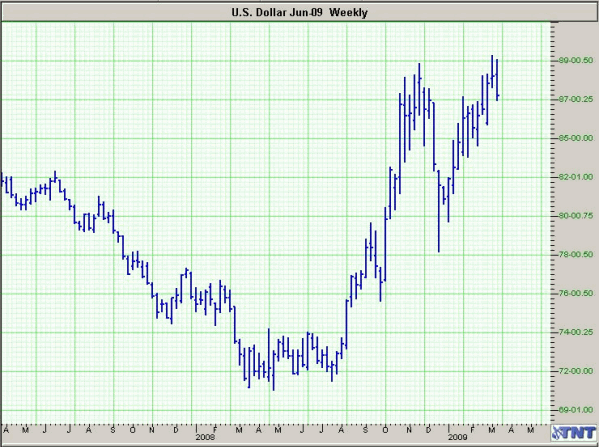| Mound Weekly Futures And Commodities Review |
| By James Mound |
Published
03/15/2009
|
Futures
|
Unrated
|
|
|
|
Mound Weekly Futures And Commodities Review
I have been writing the WCR for about a decade and I have tried over that time to make this newsletter less about the news and more about the action on the news. There are plenty of credible sources out there for news recaps. The WCR is supposed to be about cutting out the fluff and giving readers a clear directional, technical or fundamental view on a market. In that light let's take a look at the recent comments out of China about insecurity over the Fed's stability in its government bonds. This is politics at its finest. Really what China is doing is telling the Fed that if they print money to pay off debt then they will stop buying treasuries. China has supported our massively growing debt for some time. In essence the U.S. has China in a big hole. They can take a massive loss and bail on the U.S., but it would likely cause a global panic. On the flip side if China buys more of the U.S. debt it is essentially backing up their investment and funding the U.S. bailout. So what can China do about it? Well not much. But they can pressure the U.S., even if just on a PR basis, to make sure their policy is not going to dilute their investment by eroding the U.S. dollar. This is actually a very unintelligent move for China since they need some weakness in their currency against European currencies (which have recently plunged against the Yuan). A strong dollar pressures the European currencies and will likely create more strength for the Yuan against those same currencies. Nevertheless this bodes well for continued strength in the U.S. dollar as they are likely to find ways outside of printing money in the near term to pay off these large spending sprees, otherwise jeopardize their important relationship with China in the process. Net out this means a strong U.S. dollar and pressure on metals in coming weeks.
The Fed and the G-20
The G-20 meets officially the first week of April, and many anticipate a collusion of sorts to have their home countries spend more on bailout funds. However a pre-meeting this weekend went poorly in some analysts' minds as it seems the hype heading into this upcoming meeting will result more in a buy the rumor, sell the fact scenario. This week the Fed meets to determine interest rate policy, a meeting that is unlikely to change the free money policy we currently implement. The meeting should provide an avenue for the Fed to reinforce their spend-a-thon approach. What is important to take away from these two events is one overriding trend. The U.S. dollar will continue to be strong until the world sees someone else take charge. The U.S. is clearly the aggressor in this fight against global depression and that means a strong dollar.
OPEC and the Commodity Chop
OPEC met over the weekend and made no supply cuts. OPEC has become less of an implementer of oil supply controls and more of sentiment guide for global oil suppliers. What OPEC wants only happens if everyone agrees, a trend of power loss that has been going on for years. However, the lack of supply cuts this weekend is significant in a way many would not anticipate. It actually provides a unique opportunity for speculators in oil to force the trend. OPEC is not going to cut supplies but countries like Russia can step up and announce individual supply hold backs. The world is waiting for a reemergence of commodity demand. China is failing miserably at providing this and it is unlikely to happen anytime soon. But imagine what would happen right now if there was a global supply squeeze in oil. A strong U.S. dollar weakens global demand for commodities. A supply squeeze during tough economic times and amid a rising U.S. dollar would wreak global havoc. Right now many oil producing countries appear to be exceeding their supply quotas and providing the opposite function, but it is an OPEC meeting like this that can spark a strong and unexpected rally in oil prices. The dollar is king when it comes to commodities, but a stock market rally and supply squeeze in oil can neutralize a strong dollar. This is worthy of watching closely and seeing if supply drops suddenly in coming weeks.
OJ - not Simpson
It seems everyone has forgotten about poor little Orange Juice. A market that has seen an udder collapse from epic 210 highs to prices in the 60s, amounting to more than a 70% decline. Well, it is time for the OJ turnaround. Three dynamic supply and demand changes are underway. First, there is a debate out there about what the frost in January did to the crop. The frost, which occurred for two consecutive nights in Florida growing regions, had temperatures drop well below freezing for 4 plus hours. Then the USDA said it wasn't that devastating to the crop, but I would not buy into this. Yield could easily see 5-10% drops come harvest. Second, both Tropicana and the Florida Orange Growers Association are putting forth major marketing efforts this year to revitalize demand. Third, the cycle change in OJ production is clearly on the down side of the cycle, as input costs in the U.S. and Brazil will out way potential profit - especially if it is at these prices. Low supplies, increased demand and potentially shockingly low harvest could mean a huge 2009 OJ rally.

James Mound is the head analyst for www.MoundReport.com, and author of the commodity book 7 Secrets. For a free email subscription to James Mound's Weekend Commodities Review and Trade of the Month, click here.
|